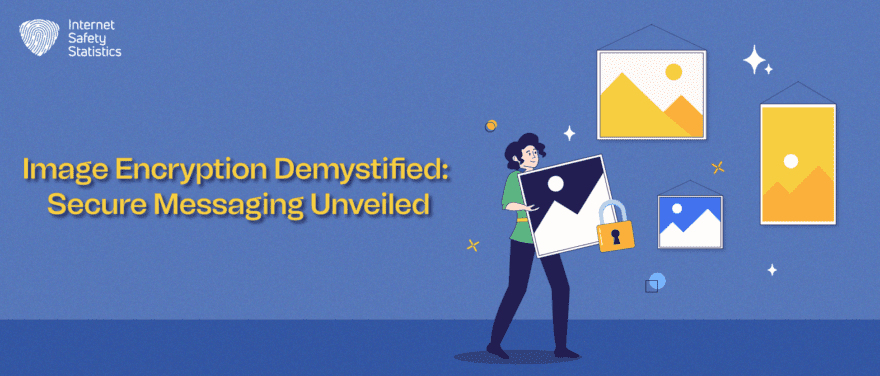
Securing information has evolved to include innovative techniques such as hiding messages within images. This article will explore the concept of image encryption and provide insights into the tools and methods for encrypting and decrypting messages hidden within images.
What is Image Encryption?
Image encryption involves the use of steganography, a technique that allows users to hide messages within an image without altering the visuals of the image. This form of encryption ensures that the message remains hidden from unintended recipients.
Specialised tools and algorithms are employed to embed the message data within the pixels of an image to hide messages within an image using encryption. This technique allows for the secure transmission of sensitive information without raising suspicion.
There are various tools available for encrypting messages in images, each with its own unique features and capabilities. These tools are designed to facilitate the seamless integration of encrypted messages into images while maintaining the integrity of the visual content.
Why Encrypt Messages in Images?
Encrypting messages in images offers several benefits, including the ability to hide sensitive information securely within seemingly innocent pictures. This technique provides a discreet way to send and receive secret messages, safeguarding the privacy and security of the communication.
Privacy and security concerns are paramount in the digital realm, and utilising image encryption for message transmission addresses these concerns effectively. Methods for securely sending secret messages through images allow users to communicate without the fear of interception or unauthorised access.
How Do You Encrypt a Message in an Image?

Encrypting a message within an image involves following a step-by-step process to embed the text message into the pixels of the image. By choosing the right image format for message encryption and applying appropriate encryption techniques, users can ensure the security of the encrypted content.
When encrypting messages in images, it is crucial to select the appropriate tools and techniques to ensure the effectiveness of the encryption process. This includes evaluating the encryption algorithm and ensuring that the chosen image format supports secure message embedding.
Encrypting a message in an image, also known as steganography, involves hiding the message within the image data in a way that’s undetectable to the naked eye. Here are some basic methods:
Least Significant Bit (LSB) Embedding
- This is the simplest and most common technique.
- Images are made up of pixels, each represented by a binary code.
- LSB embedding alters the least significant bit (rightmost) of each pixel’s colour value to encode the message in binary.
- For example, changing the LSB of a red value from 0 to 1 might represent a binary 1 in the message.
Palette Shifting
- This method works for indexed colour images with limited colour palettes.
- Specific colours in the palette are subtly shifted to represent binary data.
- For instance, shifting a blue value slightly closer to the green might represent a binary 1.
Echo Hiding
- This technique exploits slight variations in repeated patterns within the image.
- The message is encoded by subtly adjusting the spacing or intensity of these patterns.
Transform Domain Techniques
- More advanced methods involve hiding data within the mathematical transformations used to compress images, like Discrete Cosine Transform (DCT).
- These techniques offer better hiding capacity and are harder to detect.
Techniques to Hide Messages in Images
Here’s a comprehensive response on techniques to hide messages in images, incorporating visuals for clarity:
Least Significant Bit (LSB) Embedding
- How it works: Diagram of LSB embedding in image pixels: Image of LSB embedding in image pixels
- The least significant bits (LSBs) of pixel values are subtly altered to encode hidden data, often without noticeable visual changes.
- Simple but susceptible to detection if not implemented carefully.
Discrete Cosine Transform (DCT) Embedding
- How it works: Diagram of DCT embedding in image compression: Image of DCT embedding in image compression
- Hides data within the frequency coefficients of compressed images like JPEGs.
- More robust than LSB but requires compression and can be impacted by image quality adjustments.
Spread Spectrum Embedding
- How it works: Diagram of spread spectrum embedding in image pixels: Image of spread spectrum embedding in image pixels
- Distributes the message across multiple pixels, making it harder to detect and extract.
- Increases resistance to noise and interference.
Adaptive Embedding
- How it works: Diagram of adaptive embedding in image based on features: Image of adaptive embedding in image based on features
- Adjusts embedding based on image features (e.g., edges, textures) to minimise visual distortion and enhance concealment.
Steganography: The Art of Concealing
- Steganography is the practice of hiding information within other non-secret media, like images, to covertly communicate without drawing attention.
- It’s distinct from cryptography, which scrambles messages to make them unreadable without a key but doesn’t hide their existence.
Using Steganography to Encrypt and Hide Messages

Steganography is the art of concealing secret messages within ordinary, non-secret data, such as images, audio, or text files.
- Purpose: To covertly communicate or transmit information without raising suspicion about the existence of a hidden message.
- Distinction from Cryptography: While cryptography scrambles messages to make them unreadable without a key, steganography aims to hide the very presence of the message itself.
Common Techniques of Steganography
- Image Steganography:
- LSB Replacement: Hiding information in the least significant bits of an image’s colour channels.
- Frequency Domain Techniques: Embedding data in the frequency domain of an image using transformations like Discrete Cosine Transform (DCT).
- Text Steganography:
- Whitespace Steganography: Inserting hidden characters or spaces in the whitespace of a text document.
- Font-based Steganography: Using different fonts or font sizes to encode information in text.
- Audio Steganography:
- Least Significant Bit Modification: Similar to image steganography but applied to audio data.
- Phase Coding: Embedding information by altering the phase of certain audio components.
- Video Steganography:
- Frame Manipulation: Hiding data within video frames, often by modifying the least significant bits.
- Temporal Domain Techniques: Embedding information in the temporal domain of a video sequence.
- Network Steganography:
- Covering Channel: Embedding information in seemingly normal network traffic to avoid detection.
- Protocol-based Steganography: Manipulating the protocols used in network communication.
Steps to Hide a Message in an Image With Steganography
- Choose a Steganography Tool:
- Popular options include:
- Steghide (open-source, LSB and DCT embedding)
- OutGuess (advanced features, spatial and frequency domain embedding)
- OpenStego (Java-based, LSB, DCT, and adaptive embedding)
- Image Steganography (online tool for basic LSB embedding)
- Popular options include:
- Select an Image:
- Choose a suitable image format:
- JPEG for DCT-based steganography due to compression.
- BMP for uncompressed LSB embedding.
- PNG for lossless compression and metadata potential.
- GIF for unused colour palettes or control codes.
- Consider image complexity and noise to better conceal the message.
- Choose a suitable image format:
- Prepare the Message:
- Encrypt the message using a strong encryption algorithm (e.g., AES) for added security.
- Add error correction codes to handle potential data corruption.
- Embed the Message:
- Use the chosen tool to embed the encrypted message into the image.
- Specify embedding technique (LSB, DCT, spread spectrum, adaptive) based on needs.
- Save the Stego Image:
- Save the image with the hidden message, maintaining its original format.
Extracting the Hidden Message With Steganography
- Access the Stego Image:
- Retrieve the image containing the hidden message.
- Use the Right Tool:
- Use the same or compatible steganography tool used for embedding.
- Enter Extraction Parameters:
- Provide necessary information like embedding technique, password (if used), or any extraction keys.
- Extract and Decrypt:
- The tool will extract the hidden message from the image.
- Decrypt the extracted message using the corresponding decryption key.
How to Decrypt Messages Hidden in Images?
Decrypting messages hidden in images entails following a step-by-step guide to extract the hidden message from the encrypted image file. Ensuring the authenticity of the decrypted content is of utmost importance to ascertain the integrity of the retrieved message.
Security measures for decrypting hidden messages involve employing the appropriate decryption tools and techniques. Users should be cautious and aware of potential security risks when decrypting messages hidden within images to prevent unauthorised access to sensitive information.
Here are the general steps involved in decrypting messages hidden in images using steganography:
- Identify the Steganography Method:
- Look for Clues: Subtle visual distortions, unusual file sizes, or embedded metadata might hint at hidden data.
- Analyse File Structure: Inspect file headers and metadata for anomalies or patterns that suggest steganography.
- Use Steganalysis Tools: Specialised software can help detect the presence of hidden data and identify potential steganographic methods used.
- Use the Right Software:
- General-Purpose Tools:
- Steg
- Detect
- Steg
- Spyzsteg
- OutGuess
- Specific Tools:
- If you suspect a particular method (e.g., LSB embedding, transform domain techniques), use software designed for that method.
- General-Purpose Tools:
- Extract the Hidden Data:
- Decryption Key or Password: Often required for extraction.
- Software Configuration: Set parameters based on the suspected method and any available information.
- Follow Software Instructions: Most tools guide you through the extraction process.
- Interpret the Extracted Data:
- File Format: Determine the format of the extracted data (text, image, audio, etc.).
- Decryption: If encrypted, apply appropriate decryption methods using keys or passwords.
- Validation: Verify the authenticity and integrity of the extracted data.
Legal Implications of Image Decryption
The legal implications of image decryption can be a complex and nuanced topic, depending on various factors such as:
Purpose of Decryption
- Law Enforcement: Decrypting images as part of a criminal investigation to uncover illegal activity like child pornography or evidence of a crime falls under specific legal frameworks and warrants.
- Personal Use: Decrypting personal images for private purposes generally doesn’t raise legal concerns unless they involve copyrighted material or infringe on someone’s privacy.
- Commercial Use: Decrypting images for commercial purposes, such as data analysis or marketing, might require permission from the image owner or copyright holder.
Encryption Method
- Weak Encryption: Decrypting images with weak encryption may not be considered illegal, but it might raise ethical concerns about privacy and data security.
- Strong Encryption: Breaking strong encryption, even for legitimate purposes, might require specific legal authorisation or violate cybercrime laws.
Content of the Decrypted Image
- Illegal Content: Decrypting images containing illegal content like child pornography or evidence of a crime can lead to legal repercussions.
- Private Information: Decrypting images containing private information without consent might violate privacy laws and regulations.
Future of Image Encryption and Steganography

The future of image encryption and steganography is brimming with exciting possibilities and complex challenges, poised to shape the way we share, secure, and interpret visual information. Here are some key trends to watch:
Advancements in Encryption
- Quantum-resistant algorithms: The rise of quantum computing threatens current encryption methods. New algorithms based on chaos theory, DNA encoding, and homomorphic encryption offer promising solutions for a post-quantum era.
- Deep learning-powered ciphers: Artificial intelligence is revolutionising encryption. Deep neural networks can generate dynamic keys and cyphers, adapting to real-time threats and outsmarting brute-force attacks.
- Homomorphic encryption: This advanced technique allows computations on encrypted data without decryption, enabling secure analysis of medical images or financial transactions while preserving privacy.
Integration of Image Privacy in Social Media
- Differential privacy: This statistical technique adds controlled noise to images, obfuscating identifying features while preserving aggregate data insights. Imagine analysing crowd behaviour in photos without compromising individual privacy.
- Federated learning: Collaborative AI model training across devices without data sharing. Social media platforms could train image recognition models based on user photos on their own devices, protecting personal data.
- Biometric authentication for image sharing: Secure image sharing could involve facial recognition or iris scans for authorised access, preventing unauthorised sharing of sensitive content.
Emerging Trends in Image Steganography
- Coverless steganography: Hiding data in noise or unused parts of the image spectrum, like audio channels in videos, making it virtually undetectable.
- Deep learning-based embedding: AI can subtly modify image features to hide information, leading to highly resistant and imperceptible steganographic techniques.
- Steganalysis countermeasures: Advancements in steganalysis detection algorithms necessitate the development of robust countermeasures, creating an ongoing technological cat-and-mouse game.
Societal and Ethical Considerations
- Transparency and user control: Users deserve clear information about how their images are handled and encrypted. Granular control over privacy settings for image sharing and analysis is crucial.
- Ethical considerations: Steganography can be misused for malicious purposes. Strong legal and ethical frameworks are necessary to prevent abuse and protect citizens’ rights.
- Accessibility and usability: Advanced encryption and steganography shouldn’t hinder user experience. Simple and intuitive interfaces are essential for widespread adoption and secure image communication.
Implications for Society
- Enhanced journalism and whistleblowing: Encrypted image sharing can protect sensitive information from oppressive regimes, enabling journalists and whistleblowers to expose wrongdoing safely.
- Medical privacy and diagnosis: Secure transmission of medical images can improve patient care and research while safeguarding personal data.
- Secure communication in conflict zones: Encrypted image communication can protect individuals and organisations in dangerous environments, supporting humanitarian efforts and conflict resolution.
Effective usage of encryption tools requires a comprehensive understanding of the features and functionalities offered. Users should be mindful of following best practices and leveraging the capabilities of encryption tools to ensure the secure hiding of messages within images.
